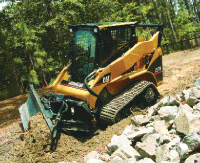
Right blade turns loaders into mini dozers
By David White*
ProductsWhen landscape contractors encounter soft, muddy underfoot conditions, sloped terrain, sensitive surfaces such as turf, or tight spaces on the job site, turning a Multi Terrain Loader (MTL) into a mini dozer may be the solution. By exerting very low ground pressure, MTLs can give operators access to areas where a larger machine would not be a practical choice for moving dirt, gravel, snow and other materials or levelling the work site in finish grading applications.
When landscape contractors encounter soft, muddy underfoot conditions, sloped terrain, sensitive surfaces such as turf, or tight spaces on the job site, turning a Multi Terrain Loader (MTL) into a mini dozer may be the solution. By exerting very low ground pressure, MTLs can give operators access to areas where a larger machine would not be a practical choice for moving dirt, gravel, snow and other materials or levelling the work site in finish grading applications.
Two types of blades are available. Rental operators can recommend that their customers test them on the job site to help determine the best fit for their needs.
 |
| The adjustability of a six-way blade is ideal for landscaping work that requires precise cuts and final grading. |
Angle blades
With a bolt-on curved moldboard and a common back interface structure, angle blades can be hydraulically angled 30 degrees right or left of centre. Adjustable, removable skid shoes add stability and provide depth control when operating on hard surfaces such as asphalt or concrete. Angle blades can be set at three different height positions to accommodate specific dozing requirements or tire arrangements.
For aggressive earthmoving applications, operators can lock the blade. For lighter tasks, the T-handled pins can be removed to enable a lighter blade tip. Landscape contractors often supplement their revenue by providing snow removal services in the winter and snow kit supplements can further expand an angle blade’s capabilities. Such kits feature bolt-on guard assemblies to increase the moldboard height by seven inches and to expand the angle blade contour and capacity. High visibility vertical edge markers indicate blade width and moldboard orientation to machine operators. The edge markers are intended to remain flexible to temperatures above minus 40 degrees F. Also available are non-metallic, reversible blade edges that are designed to squeegee material without marring concrete or asphalt surfaces such as parking lots, sidewalks and driveways.
Rental operators should suggest a blade with tilt and angle features. The materials should be reinforced to offer long life, even under harsh working conditions. The operator should have good visibility from the cab with the tool attached and clear views to the cutting edge. A quality blade should have reversible cutting edges to extend the components’ wear life, while durable, wrapped hoses will help ensure leak-free operation. Two or more of the machines in the fleet should be able to operate the work tool for added versatility and flexibility. Universal couplings should be a consideration if this kind of flexibility is desired.
Dozer blades
Dozer blades incorporate a rugged track-type tractor variable power angle tilt blade with simultaneous tilt and angle capability for superior control and manoeuvrability. The centre section of its bolt-on cutting edge is reversible to extend wear life. Angled end bits, modelled after track-type tractor blades, allow flush cutting against a vertical surface when the blade is fully tilted. Adjustable, removable skid shoes enhance stability and control depth when operating on a surface such as asphalt or concrete.
Bolt-on edge segments further protect the cutting edge, lengthening the usable life of the tool. The edge is a structural component of the work tool and its blade becomes weakened if it is unprotected.
When recommending a blade, ask the customer about the application in which it will be used most often. Landscaping work typically requires more precise cuts and final grading, so the adjustability of a six-way blade is ideal for this type of application. Angle blades are better suited for rough grading, snow removal and general earthmoving tasks.
Contractors that use blades mostly for grading often seek the widest blade configuration possible to extend beyond the tracks; however, this may not always be the most efficient, or the most advantageous for a particular customer. This presents an opportunity for the rental operator to suggest the right tool for the job.
*David White is the marketing co-ordinator for Battlefield Equipment Rentals in Stoney Creek, Ont. Battlefield Equipment operates Cat Rental stores and is a Caterpillar dealer for Compact Equipment in Ontario, Manitoba and Newfoundland.
Print this page
Leave a Reply